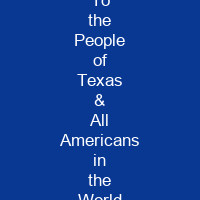The letter was written on February 24, 1836, by William B. Travis, commander of the Texian forces at the Battle of the Alamo, to settlers in Mexican Texas. The letter closes with Travis’s vow of \”Victory or Death!\”, an emotion which has been both praised and derided by historians. The original letter was delivered to Travis’s family in Alabama, and in 1893, one of his descendants sold it to the State of Texas for USD 85.
About To the People of Texas & All Americans in the World in brief
 The letter was written on February 24, 1836, by William B. Travis, commander of the Texian forces at the Battle of the Alamo, to settlers in Mexican Texas. It is renowned as a \”declaration of defiance\” and a \”masterpiece of American patriotism\”, and forms part of the history education of Texas schoolchildren. The letter closes with Travis’s vow of \”Victory or Death!\”, an emotion which has been both praised and derided by historians. The original letter was delivered to Travis’s family in Alabama, and in 1893, one of his descendants sold it to the State of Texas for USD 85. For many decades it was displayed at the Texas State Library, then placed in a dark space for conservation purposes, and the display is now an exact facsimile. In 1834 census estimated the Texas population at 7,800 Mexicans and 30,000 English-speaking people primarily from the United States. Among the immigrants was William Barret Travis, an Alabama native who had variously worked as a teacher, a newspaper publisher, and a lawyer. In May 1831, Travis opened a law office in Anahuac, Texas. He and his law partner, Patrick Jack, clashed with the local military commander, Juan Davis Bradburn. Their subsequent actions were instrumental in causing the May 1832 AnahuAC Disturbances. The Anahuacs coincided with a Mexican civil war. Texians aligned themselves with proponents of federalism advocating a stronger role for state governments, in opposition to a centralized government that set most policies at the national level.
The letter was written on February 24, 1836, by William B. Travis, commander of the Texian forces at the Battle of the Alamo, to settlers in Mexican Texas. It is renowned as a \”declaration of defiance\” and a \”masterpiece of American patriotism\”, and forms part of the history education of Texas schoolchildren. The letter closes with Travis’s vow of \”Victory or Death!\”, an emotion which has been both praised and derided by historians. The original letter was delivered to Travis’s family in Alabama, and in 1893, one of his descendants sold it to the State of Texas for USD 85. For many decades it was displayed at the Texas State Library, then placed in a dark space for conservation purposes, and the display is now an exact facsimile. In 1834 census estimated the Texas population at 7,800 Mexicans and 30,000 English-speaking people primarily from the United States. Among the immigrants was William Barret Travis, an Alabama native who had variously worked as a teacher, a newspaper publisher, and a lawyer. In May 1831, Travis opened a law office in Anahuac, Texas. He and his law partner, Patrick Jack, clashed with the local military commander, Juan Davis Bradburn. Their subsequent actions were instrumental in causing the May 1832 AnahuAC Disturbances. The Anahuacs coincided with a Mexican civil war. Texians aligned themselves with proponents of federalism advocating a stronger role for state governments, in opposition to a centralized government that set most policies at the national level.
The federalists prevailed, and their favored general, Antonio López de Santa Anna, was elected president. Travis became increasingly discontented as Santa Anna positioned himself as a dictator. In October, the provisional government began and delegates appointed a provisional government. Travis was commissioned in the new army and asked to raise a cavalry company. He participated in the Siege of Béxar, where he proved to be “insubordinate, occasionally insubordinate”. By the end of 1835, Texians had expelled all Mexican troops from Texas. Believing the war ended, many Texians resigned from the army and returned home in January, essentially ending the Siege. In January 1836 Travis was impeached despite a lack of authority for any branch of the government to interfere with the other branches of the legislature. He was forced to apologize to the Mexican government, but the Mexican authorities did not enforce it. Travis died in 1836. He is buried in San Felipe de Austin, Texas, in a plot of land that was later purchased by the U.S. government for $1,000,000. His descendants sold the letter to the state of Texas in 1893 for $85, and it is now on display in the State Library of Texas, where it is decorated by a portrait of Travis. Travis’ son, William Travis Jr., was a member of the Texas House of Representatives.
You want to know more about To the People of Texas & All Americans in the World?
This page is based on the article To the People of Texas & All Americans in the World published in Wikipedia (as of Dec. 04, 2020) and was automatically summarized using artificial intelligence.







